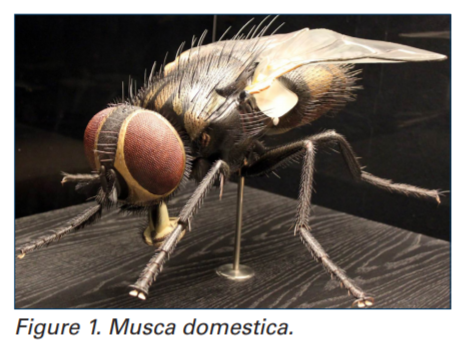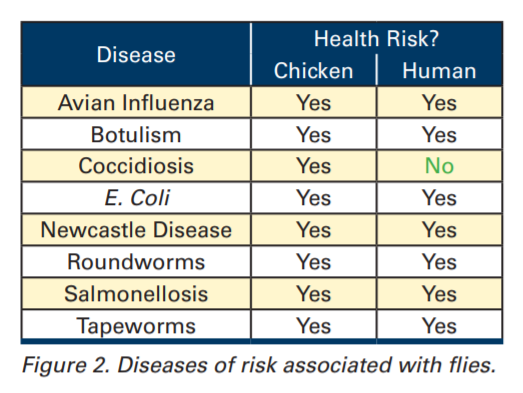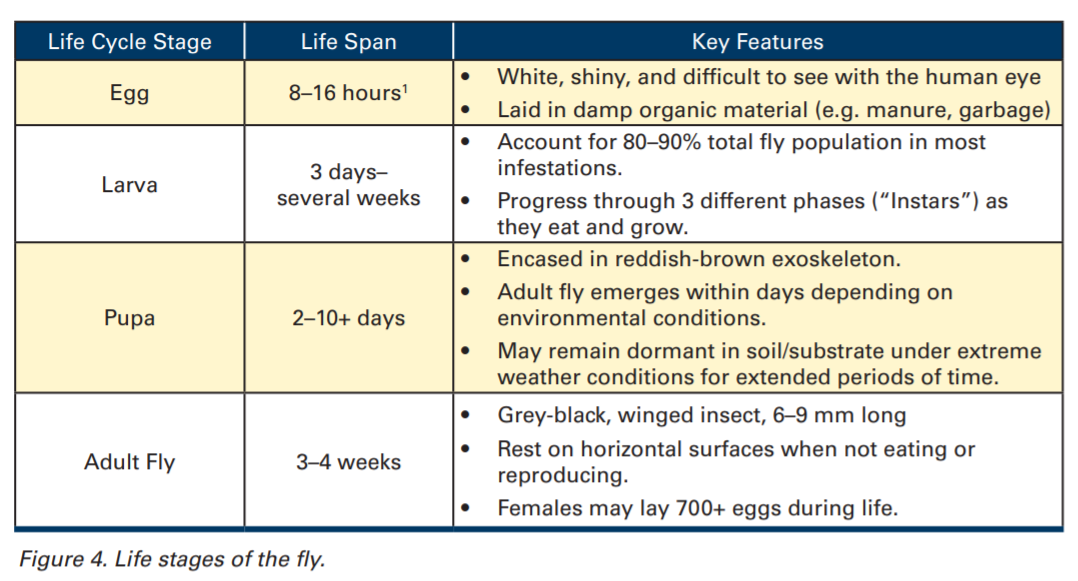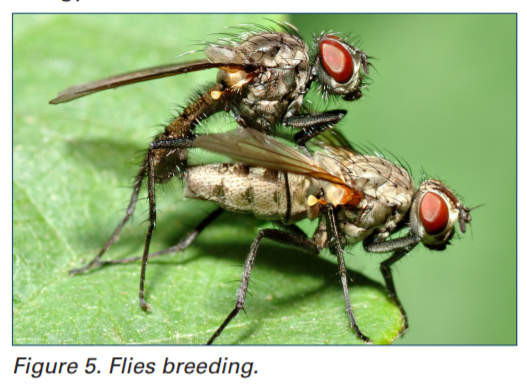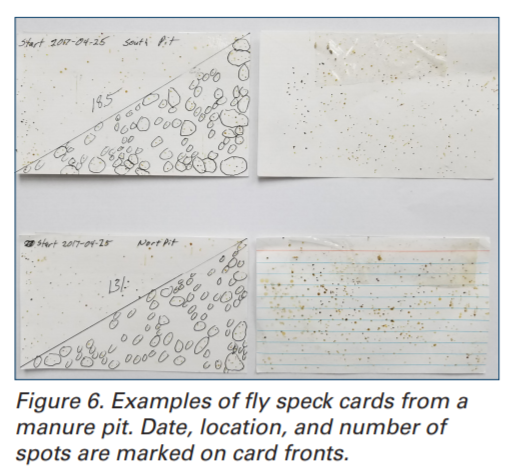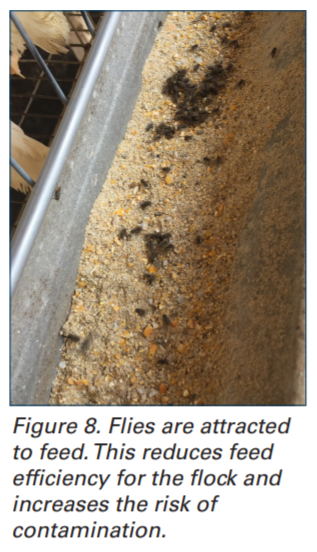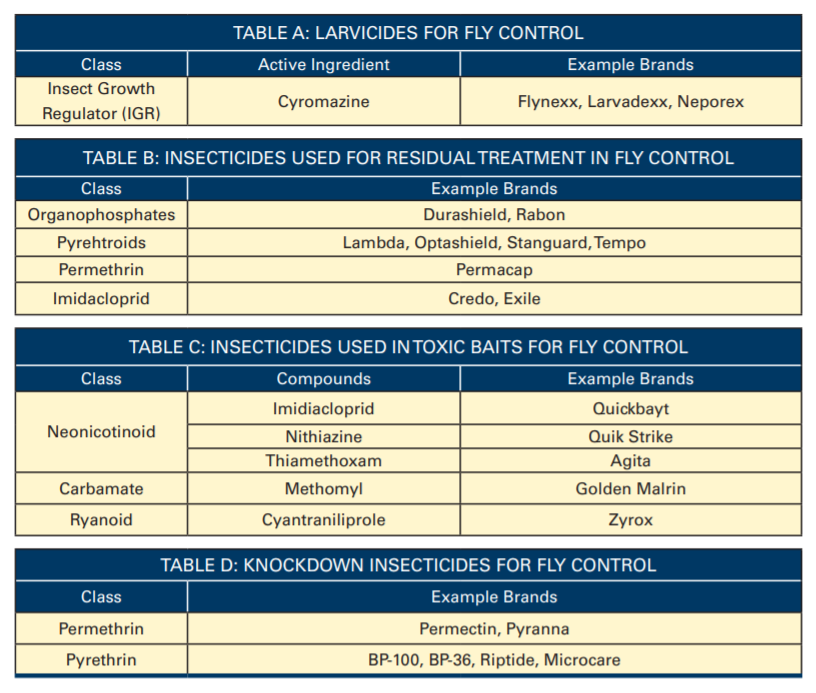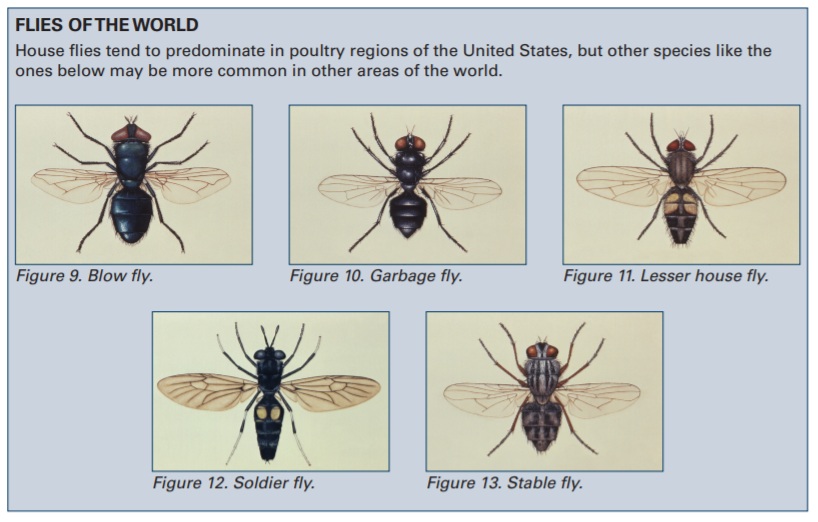



Fly Management: Surveillance and control
Fly infestations pose a significant challenge for poultry operations. Whether concentrated in a pit system, holding shed, or on a litter floor, poultry manure is an ideal medium for fly reproduction.Introduction
Large fly populations can cause discomfort, stress, and fly biology and ecology decreased production in egg-laying chickens, pullets, and breeders. Flies also serve as a vector of both bird and human diseases. In extreme cases, failure to control flies may result in poor community relations or even litigation. Fly control and prevention is essential for success in the rearing and production of egglaying chickens.
A basic understanding of the life cycle of flies and their interaction with their environment is important for developing strategies to reduce their impact. The following is focused on the house fly (musca domestica), a major pest on poultry farms.
Health Risks of Flies
Flies are known to be vectors for many diseases of both humans and livestock, and are considered a sign of unsanitary conditions. Flies may transmit disease by carrying viruses, bacteria, parasites, and fungi on their bodies, or through their mouthparts after contacting or ingesting infectious materials. Chickens may eat flies at any life stage, and can become infected by ingesting the insects or by direct contact. Fly populations may also create a reservoir for disease on poultry farms, making disease treatment and elimination more difficult. Figure 2 outlines several major diseases of concern for poultry that flies may carry, though there are many more [2, 3, 5, 6, 8, 9].
Life Cycle
Flies pass through four distinct life cycle stages: egg, larva (maggot), pupa, and adult fly. The lifespan of flies from egg to adult is usually 2–3 weeks, but can vary depending on environmental factors including temperature, and be as long as 3 months under cool conditions. Figures 3 and 4 give an overview of these life stages [9].
Breeding Sites
Flies reproduce and lay their eggs in rotting, decayed, or fermenting organic matter (e.g. garbage, manure, etc.) with moisture content between 50–85%. Fresh poultry manure has approximately 75–80% moisture content, making it highly desirable as a medium for development of fly populations [5].
Diet
Fly larvae have chewing mouth-parts, and consume any rotting organic material in their environment. Adult flies have sucking mouthparts (proboscis), and must consume food that is already in a liquid state, or can be dissolved by their acidic saliva. Eggs and pupae stage flies do not eat, and survive entirely on stored energy [9].
Behaviour and Distribution
As with diet, the behaviour and distribution of flies varies by life-stage. Eggs are laid in organic material with 50–85% moisture content. Larvae remain in this environment, burrowing into the material. They must remain near the surface where conditions are moist, and they have access to oxygen. Their only activities are feeding and hiding. As the larvae mature they seek out drier material, and dig deeper beneath the surface (1–3 cm) [9].
After the adult fly emerges it is mainly active during daylight hours when it breeds and eats. Adult fly populations may have an activity range of 0.8–3.2 km (0.5–2.0 miles). They can travel much further by “hitching a ride” in a travelling car or truck. At night and any time when they are not eating or breeding, adults are considered at rest, or "roosting." Adults roost on any stable surface they can find (floors, walls, ceilings, furniture, plants, fences, garbage cans, etc.), preferring locations close to breeding or feeding sites. They may also adapt their activity somewhat to artificial lighting schedules [5, 9].
Adult flies are most active at temperatures between 20–25°C (68–77°F) with low humidity. At higher temperatures (greater than 95°F/35°C), they will spend more time resting, and may prefer to be outdoors. At temperatures below 10°C (50°F), adult flies and pupae may remain alive, but dormant [9].
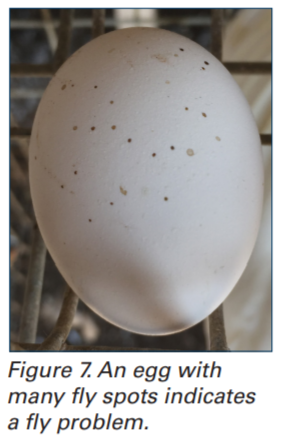
Monitoring
Systematic monitoring of fly populations helps in decision making about when and where to deploy insecticides. It also can provide for a legal record in the event of a public health or nuisance complaints relating to flies originating from the farm. A consistent and reliable fly surveillance method provides a more accurate reference point for fly numbers than simple observation of adult flies. Sticky fly tape is inexpensive and may help with identification of fly species. Hanging of tape in the aisles of chicken houses must be done strategically in areas where flies are more likely to circulate (such as near manure belts, or water lines), or fly numbers may appear lower than they really are. Additionally, tape may become clogged with dust making them ineffective within just a few days. An alternative use of is to take a moving tape count; walking a routine area of likely fly activity in each house (304 m/1,000 ft), while holding tape and counting the number of flies caught.
Fly speck cards are another inexpensive means of fly monitoring (Figure 6). White index cards (8x12 cm/3x5 in) can be hung from the ceiling or rafters of the manure pit and other fly resting areas. Fly specks (brown spots left when flies land on the cards) are counted weekly. Fifty spots/card per week is a standard beyond which fly treatment with bait and residual adulticides is called for. 100 spots/card per week or more indicates use of a contact adulticide. Cards should be checked and changed at least once a week, but may need to be screened and changed more often if fly numbers are high. Cards should always be strategically positioned in the same location. Cards are easily dated and filed for record-keeping purposes.
Fly traps can be hung from wire or placed on the floor of manure pit. Traps should be checked and bait replaced at least once a week. Traps are more costly to set up and change than speck cards, but they kill flies and allow for identification of fly species.
Screening for larvae in the manure pit is as important as monitoring for adult flies. The manure pit should be walked daily to screen for wet spots or areas where flies are visibly concentrated. Manure can be dug up to look for eggs and larva just below the surface. This provides an opportunity for precise application of larvicide and manure drying chemicals. Daily manure production covers treated areas, necessitating regular inspection of the pit [6, 9].
Fly control strategies
Developing an effective fly control program is important for the success of any poultry operation. The most successful programs combine multiple control methods with diligent monitoring to minimise the economic and health threats posed by flies.
Sanitation
Manure management is the single most important aspect of fly control in poultry operations. Drying manure to less than 50% moisture content makes it a poor environment for fly reproduction. The manure pit must be walked daily to screen for fly blooms and wet spots. When wet spots are found the source of excess moisture needs to be identified and corrected. Common sources include leaking water lines, condensation from faulty insulation, improper ventilation (drying failure), and leaks from outside. Ventilation of the manure area with exhaust fans and air-circulating fans in the manure pit is important to aid in manure drying. Both indoor and outdoor manure and feed spills should be minimised and cleared as soon as they are noticed.
Dead birds, as well as cracked, dirty, and floor eggs should be disposed of quickly and securely as far from the chicken house as possible. Maintain clean office, entry, and break areas. Clearing grass, weeds, and clippings near the facility’s perimeter or in nearby features like drainage ditches eliminates potential outdoor fly resting areas [5, 6, 9].
Structural Defences
Maintenance of biosecurity barriers prevents outdoor flies and other pests from entering bird areas. Look for and seal cracks and breaches in the barn and connected structures such as feed bins and manure loadout sheds. Doors should be opened only when absolutely necessary. Generally, enough force is produced by exhaust fans in the chicken house or manure pit to prevent flies entering against active airflow. However, when fans are not running they provide an ideal access portal for flies to enter the building. Fan louvers should always be closed to prevent flies entering the building when fans are off. If exhaust fan louvers, or any other area, must remain open for passive airflow, the opening should be screened with a fine, securely installed mesh.
Physical fly traps placed near major access points can attract flies away from breeding areas. Baited traps can be made from jugs, cans or buckets and placed near portals or hung from the rafters of the pit. Sticky fly tape is less expensive and may serve the same purpose. Both of these traps also can be used for fly monitoring, but must be regularly checked and replaced to remain effective. Electrocuter light traps (“bug zappers”) are effective, but costly, and are therefore of greater value in human working (offices, egg sorting rooms, etc.) and egg storage and transfer areas [6, 9].
Biological Defences
Maintaining populations of other organisms that compete with or prey on flies can help to compliment other elements of a fly control program. Special attention must be paid in selecting which species to use for fly-control so as not to introduce a new pest. For example, hister beetles are well-known predators of fly eggs, and dump flies can successfully outcompete house flies, but both of these species can still carry and transfer poultry diseases. Certain mites thrive in poultry manure (Macrocheles muscae domesticate and Fuscurooda vegetans) and feed on fly eggs and larvae, but care must be taken not to confuse them with other mite species that are parasitic to chickens. Parasitic wasps can be purchased commercially, and introduced near fly breeding areas. When they emerge, they will seek out fly pupae and lay eggs inside them, killing the fly at this life stage. Large fly populations can quickly overwhelm biological control methods, so they should always be used in conjunction with other strategies [2, 3, 8]. In integrating parasitic wasps into
a control strategy, it is important to be aware that many knockdown adulticides will also kill the wasps.
In addition to insects, microorganisms that harm flies may be introduced into the farm system. The bacterium Bacillus thuringiensis causes disease in flies, but not chicken or people. Where available, it may be spread on chicken manure directly, or fed through the chicken as a feed additive [7].
Chemical Control
There are four basic types of chemical insecticide fly control: larvicides, residual adulticides, baits, and contact adulticides. Larvicides include contact larvicides and insect growth regulators (IGRs). They may be sprayed onto maggot infested areas directly, or, when manure is very wet, may be applied as a dry granule.
Residual adulticides are sprayed on surfaces where newly emerged flies are likely to rest. Residues may last from days to months depending on the product, and the surface it is applied to (porous surfaces like wood may absorb the chemical rapidly).
Examples of residual adulticides by class are outlined in Table B. Follow local regulations regarding the use of fly control products in poultry facilities. Baits will attract flies and can be used in traps or as spot-on treatments indoors and outdoors. Some neonicotinoid, ryanoid, and carbamate class baits are outlined in Table C. Contact adulticides can be fogged, misted, or sprayed as a last resort when other control measures fall short. These are generally pyrethrin or permethrin class products. Refer to Table D for example contact adulticides [2, 4, 5, 6, 8, 9].
Resistance and Rotation
Unfortunately, overuse of popular insecticide products over the years has led to the development of resistant fly populations. Rotation of the product used can help reduce the likelihood of resistance emerging. When rotating products changes should be made on the basis of chemical class (e.g. organophasphate or pyrethroid) rather than the brand.
Precise use of insecticides can help to reduce the development of resistance, as well as reduce the cost of treatment. Overuse of insecticides in manure areas may kill helpful biological defenders against flies. An effective monitoring program can guide decisions about precise and prudent insecticide applications [1, 2, 8].
Human Health Risks
Always read and follow the manufacturer’s instructions for safe handling and personal protection whenever handling insecticides. Have appropriate gloves, goggles, clothing, footwear, respiratory protection, and any other personal protective equipment (PPE) indicated by the chemical’s safety labelling. When in doubt, request an SDS (safety data sheet) from your vendor or supervisor.
In addition to direct human and animal health cautions, insecticides and cleaning chemicals may contaminate birds or eggs, rendering them unfit for consumption. For example, the chemical fipronil, present in some insecticides, can be passed into eggs if ingested by or applied on chickens. Be certain to use only products labelled for use around chickens in areas where bird contact is possible.
References
1. Bailey, D.L., D. W. Meifert, and P. M. Bishop. "Control of house flies in poultry houses with larvicides." Florida Entomologist (1968): 107–111.
2. Catangui, M. “Controlling disease-carrying house flies in poultry houses”. Poultry Outlook Spring 2017. (2017): 11–14.
3. Catangui, M. “Getting to know the dump fly”. Poultry Outlook Summer 2017. (2017): 10.
4. Catangui, M. “To larvicide or not: is that the question?” Poultry Outlook Summer 2017. (2017): 13–15.
5. Kauffman, P.E., D.A. Ruiz, and C.W. Pitts. Pest Management Recommendations for Poultry. The Pennsylvania State University. (2000)
6. Lyon, W.F. Poultry Pest Management. The Ohio State University Extension Bulletin 853. (1995)
7. Merdan, B.A. “Bacillus thuringiensis as a feed additive to control Musca domestica associated with poultry houses”. J. Basic & Appl Zoology (2012) 65: 83–87.
8. Rowland, R. Chapter 11: Insect Problems in Poultry Production Facilities Chapter for Risk Management for Disease Prevention in the Poultry Industry. A Practical Guide for Managing Risk in Poultry Production. 2nd edition. Jacksonville: American Association of Avian Pathologists, Inc. (2017). 151–157.
9. World Health Organization. Chapter 6: Houseflies. Vector Control – Methods for Use by Individuals and Communities. 1997. 302–323. Online Edition.
IMAGE SOURCES
Figure 1: Anagoria (username). “2013 Naturkundemuseum Berlin musca domestica anagoria.” 9 March 2013. Online image. Wikimedia Commons. 27 October 2017. https://commons.wikimedia. org/wiki/File:2013_Naturkundemuseum_ Berlin_musca_domestica_anagoria.JPG. Creative Commons license at https://creativecommons.org licenses/by/3.0/deed. en.
Figures 2–4: Hy-Line International.
Figure 5: André Karwath. “Anthomyiidae sp. 1 (aka.jpg.” 8 September 2005. Online image. Wikimedia Commons. 28 March 2018. https://commons.wikimedia.org/wiki/ File:Anthomyiidae_sp._1_(aka).jpg. Creative Commons license https://creativecommons.org/licenses/by-sa/2.5/deed.en.
Figures 6–8: Hy-Line International.
Figures 9–13: Centers for Disease Control and Prevention.







